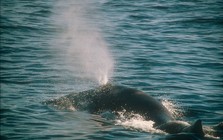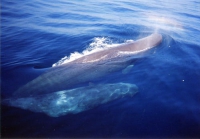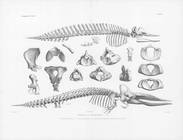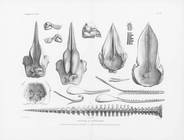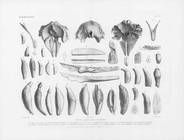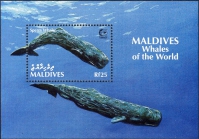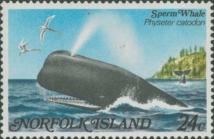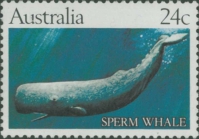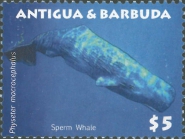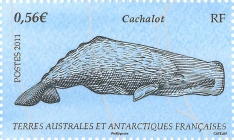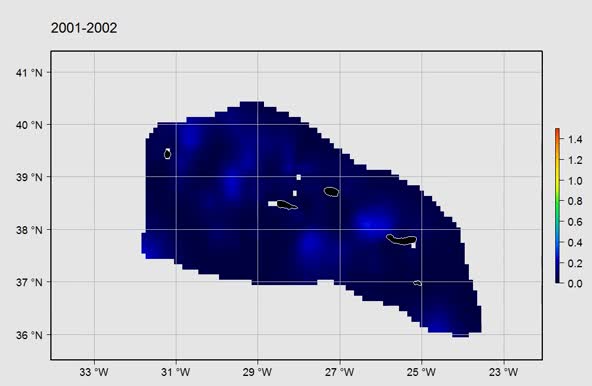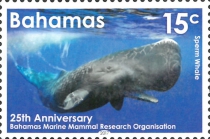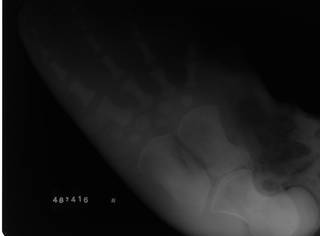WoRMS taxon details
Physeter macrocephalus Linnaeus, 1758
137119 (urn:lsid:marinespecies.org:taxname:137119)
accepted
Species
Catodon (Meganeuron) krefftii Gray, 1865 · unaccepted (synonym)
Catodon australis Wall, 1851 · unaccepted (synonym)
Catodon colneti Gray, 1850 · unaccepted (synonym)
Catodon macrocephalus Lacépède, 1804 · unaccepted (synonym)
Cetus cylindricus Billberg, 1828 · unaccepted (synonym)
Delphinus bayeri Risso, 1826 · unaccepted (synonym)
Phiseter cylindricus Bonnaterre, 1789 · unaccepted (synonym)
Phiseter mular Bonnaterre, 1789 · unaccepted (synonym)
Phiseter trumpo Bonnaterre, 1789 · unaccepted (synonym)
Physalus cylindricus Lacépède, 1804 · unaccepted (synonym)
Physeter andersonii Borowski, 1780 · unaccepted (synonym)
Physeter australasiensis Desmoulins, 1822 · unaccepted (synonym)
Physeter australis Gray, 1846 · unaccepted (synonym)
Physeter catodon Linnaeus, 1758 · unaccepted (synonym)
Physeter maximus G. Cuvier, 1798 · unaccepted (synonym)
Physeter microps Linnaeus, 1758 · unaccepted (synonym)
Physeter microps rectidentatus Kerr, 1792 · unaccepted (synonym)
Physeter novaeangliae Borowski, 1780 · unaccepted (synonym)
Physeter orthodon Lacépède, 1804 · unaccepted (synonym)
Physeter tursio Linnaeus, 1758 · unaccepted (synonym)
Physeterus sulcatus Lacépède, 1818 · unaccepted (synonym)
Tursio vulgaris Fleming, 1822 · unaccepted (synonym)
- Subspecies Physeter macrocephalus albicans Kerr, 1792 accepted as Delphinapterus leucas (Pallas, 1776) (synonym)
- Subspecies Physeter macrocephalus cinereus Kerr, 1792 (uncertain > nomen dubium)
- Subspecies Physeter macrocephalus niger Kerr, 1792 (uncertain > nomen dubium)
marine, terrestrial
Linnaeus, C. (1758). Systema Naturae per regna tria naturae, secundum classes, ordines, genera, species, cum characteribus, differentiis, synonymis, locis. <em>Editio decima, reformata [10th revised edition], vol. 1: 824 pp. Laurentius Salvius: Holmiae.</em> , available online at https://biodiversitylibrary.org/page/726886
page(s): 76 [details] Available for editors [request]
[request]
page(s): 76 [details] Available for editors
Note "Oceano Europaeo"
From editor or global species database
Type locality "Oceano Europaeo" [details]
Distribution in all oceans; Antarctica/Southern Ocean; East Pacific; Eastern Atlantic Ocean; Indo-West Pacific; Western Atlantic Ocean.
Distribution in all oceans; Antarctica/Southern Ocean; East Pacific; Eastern Atlantic Ocean; Indo-West Pacific; Western Atlantic Ocean. [details]
Fordyce, E.; Perrin, W.F. (2024). World Cetacea Database. Physeter macrocephalus Linnaeus, 1758. Accessed through: World Register of Marine Species at: https://www.marinespecies.org/aphia.php?p=taxdetails&id=137119 on 2024-04-27
Date
action
by
![]() The webpage text is licensed under a Creative Commons Attribution 4.0 License
The webpage text is licensed under a Creative Commons Attribution 4.0 License
original description
Linnaeus, C. (1758). Systema Naturae per regna tria naturae, secundum classes, ordines, genera, species, cum characteribus, differentiis, synonymis, locis. <em>Editio decima, reformata [10th revised edition], vol. 1: 824 pp. Laurentius Salvius: Holmiae.</em> , available online at https://biodiversitylibrary.org/page/726886
page(s): 76 [details] Available for editors [request]
[request]
original description (of Physeter tursio Linnaeus, 1758) Linnaeus, C. (1758). Systema Naturae per regna tria naturae, secundum classes, ordines, genera, species, cum characteribus, differentiis, synonymis, locis. <em>Editio decima, reformata [10th revised edition], vol. 1: 824 pp. Laurentius Salvius: Holmiae.</em> , available online at https://biodiversitylibrary.org/page/726886 [details] Available for editors [request]
[request]
original description (of Physeter catodon Linnaeus, 1758) Linnaeus, C. (1758). Systema Naturae per regna tria naturae, secundum classes, ordines, genera, species, cum characteribus, differentiis, synonymis, locis. <em>Editio decima, reformata [10th revised edition], vol. 1: 824 pp. Laurentius Salvius: Holmiae.</em> , available online at https://biodiversitylibrary.org/page/726886
page(s): 76 [details] Available for editors [request]
[request]
original description (of Physeter microps Linnaeus, 1758) Linnaeus, C. (1758). Systema Naturae per regna tria naturae, secundum classes, ordines, genera, species, cum characteribus, differentiis, synonymis, locis. <em>Editio decima, reformata [10th revised edition], vol. 1: 824 pp. Laurentius Salvius: Holmiae.</em> , available online at https://biodiversitylibrary.org/page/726886 [details] Available for editors [request]
[request]
context source (Deepsea) Intergovernmental Oceanographic Commission (IOC) of UNESCO. The Ocean Biogeographic Information System (OBIS), available online at http://www.iobis.org/ [details]
context source (HKRMS) Jefferson TA. (2005). Monitoring of Indo-Pacific Hampback Dolphin (Sousa chinensis) in Hong Kong waters - Data Analysis. Final report. Submitted to the Agriculture &Fisheries and Conservation Department, The Hong Kong SAR Government. [details]
context source (Bermuda) Sterrer, W. (1986). Marine fauna and flora of Bermuda: a systematic guide to the identification of marine organisms. <em>Wiley-Interscience Publication. Wiley.</em> 742 pp (Nemertini part). [details] Available for editors [request]
[request]
basis of record van der Land, J. (2001). Tetrapoda, <B><I>in</I></B>: Costello, M.J. <i>et al.</i> (Ed.) (2001). <i>European register of marine species: a check-list of the marine species in Europe and a bibliography of guides to their identification. Collection Patrimoines Naturels,</i> 50: pp. 375-376 (look up in IMIS) [details]
additional source Mead, J. G.; Brownell, R. L. Jr. (2005). Cetacea. <em>In Wilson, D.E. & D.M. Reeder (eds). Mammal Species of the World. A Taxonomic and Geographic Reference (3rd ed), Johns Hopkins University Press, 2,142 pp.</em> 723--743., available online at http://www.bucknell.edu/msw3/ [details]
additional source Rice, D. W. (1998). Marine mammals of the world. Systematics and distribution. <em>Society for Marine Mammalogy Special Publication.</em> 4., available online at http://www.marinemammalscience.org/wp-content/uploads/2014/09/MarineMammalsOfTheWorld.pdf [details]
additional source Hershkovitz, P. (1966). Catalog of Living Whales. <em>Bulletin of the United States National Museum.</em> (246): 1-259., available online at https://doi.org/10.5479/si.03629236.246 [details]
additional source Jefferson, T. A., M. A. Webber and R. L. Pitman. (2008). Marine mammals of the world. Academic Press, Amsterdam. [details]
additional source IUCN Red List of Threatened Species, available online at http://www.iucnredlist.org [details]
additional source Perrin, W.F.; Würsig, B.; Thewissen, J.G.M. (2009). Encyclopedia of marine mammals. Second edition. Academic Press: London. ISBN 978-0-12-373553-9. xxix, 1316 pp. (look up in IMIS) [details]
additional source King, C.M.; Roberts, C.D.; Bell, B.D.; Fordyce, R.E.; Nicoll, R.S.; Worthy, T.H.; Paulin, C.D.; Hitchmough, R.A.; Keyes, I.W.; Baker, A.N.; Stewart, A.L.; Hiller, N.; McDowall, R.M.; Holdaway, R.N.; McPhee, R.P.; Schwarzhans, W.W.; Tennyson, A.J.D.; Rust, S.; Macadie, I. (2009). Phylum Chordata: lancelets, fishes, amphibians, reptiles, birds, mammals. <em>in: Gordon, D.P. (Ed.) (2009). New Zealand inventory of biodiversity: 1. Kingdom Animalia: Radiata, Lophotrochozoa, Deuterostomia.</em> pp. 431-554. [details]
additional source Schmidly, D. J. and B. Würsig. 2009. Mammals (Vertebrata: Mammalia) of the Gulf of Mexico, Pp. 1343–1352 in Felder, D.L. and D.K. Camp (eds.), Gulf of Mexico–Origins, Waters, and Biota. Biodiversity. Texas A&M Press, College Station, Texas. [details]
additional source Liu, J.Y. [Ruiyu] (ed.). (2008). Checklist of marine biota of China seas. <em>China Science Press.</em> 1267 pp. (look up in IMIS) [details] Available for editors [request]
[request]
additional source Bearzi, G.; Pierantonio, N.; Affronte, M.; Holcer, D.; Maio, N.; Notarbartolo Di Sciara, G. (2011). Overview of sperm whale Physeter macrocephalus mortality events in the Adriatic Sea, 1555-2009. <em>Mammal Review.</em> 41(4): 276-293., available online at https://doi.org/10.1111/j.1365-2907.2010.00171.x [details] Available for editors [request]
[request]
additional source Integrated Taxonomic Information System (ITIS). , available online at http://www.itis.gov
page(s): 76 [details]
ecology source Looby, A.; Erbe, C.; Bravo, S.; Cox, K.; Davies, H. L.; Di Iorio, L.; Jézéquel, Y.; Juanes, F.; Martin, C. W.; Mooney, T. A.; Radford, C.; Reynolds, L. K.; Rice, A. N.; Riera, A.; Rountree, R.; Spriel, B.; Stanley, J.; Vela, S.; Parsons, M. J. G. (2023). Global inventory of species categorized by known underwater sonifery. <em>Scientific Data.</em> 10(1). (look up in IMIS), available online at https://doi.org/10.1038/s41597-023-02745-4 [details]
page(s): 76 [details] Available for editors
original description (of Physeter tursio Linnaeus, 1758) Linnaeus, C. (1758). Systema Naturae per regna tria naturae, secundum classes, ordines, genera, species, cum characteribus, differentiis, synonymis, locis. <em>Editio decima, reformata [10th revised edition], vol. 1: 824 pp. Laurentius Salvius: Holmiae.</em> , available online at https://biodiversitylibrary.org/page/726886 [details] Available for editors
original description (of Physeter catodon Linnaeus, 1758) Linnaeus, C. (1758). Systema Naturae per regna tria naturae, secundum classes, ordines, genera, species, cum characteribus, differentiis, synonymis, locis. <em>Editio decima, reformata [10th revised edition], vol. 1: 824 pp. Laurentius Salvius: Holmiae.</em> , available online at https://biodiversitylibrary.org/page/726886
page(s): 76 [details] Available for editors
original description (of Physeter microps Linnaeus, 1758) Linnaeus, C. (1758). Systema Naturae per regna tria naturae, secundum classes, ordines, genera, species, cum characteribus, differentiis, synonymis, locis. <em>Editio decima, reformata [10th revised edition], vol. 1: 824 pp. Laurentius Salvius: Holmiae.</em> , available online at https://biodiversitylibrary.org/page/726886 [details] Available for editors
context source (Deepsea) Intergovernmental Oceanographic Commission (IOC) of UNESCO. The Ocean Biogeographic Information System (OBIS), available online at http://www.iobis.org/ [details]
context source (HKRMS) Jefferson TA. (2005). Monitoring of Indo-Pacific Hampback Dolphin (Sousa chinensis) in Hong Kong waters - Data Analysis. Final report. Submitted to the Agriculture &Fisheries and Conservation Department, The Hong Kong SAR Government. [details]
context source (Bermuda) Sterrer, W. (1986). Marine fauna and flora of Bermuda: a systematic guide to the identification of marine organisms. <em>Wiley-Interscience Publication. Wiley.</em> 742 pp (Nemertini part). [details] Available for editors
basis of record van der Land, J. (2001). Tetrapoda, <B><I>in</I></B>: Costello, M.J. <i>et al.</i> (Ed.) (2001). <i>European register of marine species: a check-list of the marine species in Europe and a bibliography of guides to their identification. Collection Patrimoines Naturels,</i> 50: pp. 375-376 (look up in IMIS) [details]
additional source Mead, J. G.; Brownell, R. L. Jr. (2005). Cetacea. <em>In Wilson, D.E. & D.M. Reeder (eds). Mammal Species of the World. A Taxonomic and Geographic Reference (3rd ed), Johns Hopkins University Press, 2,142 pp.</em> 723--743., available online at http://www.bucknell.edu/msw3/ [details]
additional source Rice, D. W. (1998). Marine mammals of the world. Systematics and distribution. <em>Society for Marine Mammalogy Special Publication.</em> 4., available online at http://www.marinemammalscience.org/wp-content/uploads/2014/09/MarineMammalsOfTheWorld.pdf [details]
additional source Hershkovitz, P. (1966). Catalog of Living Whales. <em>Bulletin of the United States National Museum.</em> (246): 1-259., available online at https://doi.org/10.5479/si.03629236.246 [details]
additional source Jefferson, T. A., M. A. Webber and R. L. Pitman. (2008). Marine mammals of the world. Academic Press, Amsterdam. [details]
additional source IUCN Red List of Threatened Species, available online at http://www.iucnredlist.org [details]
additional source Perrin, W.F.; Würsig, B.; Thewissen, J.G.M. (2009). Encyclopedia of marine mammals. Second edition. Academic Press: London. ISBN 978-0-12-373553-9. xxix, 1316 pp. (look up in IMIS) [details]
additional source King, C.M.; Roberts, C.D.; Bell, B.D.; Fordyce, R.E.; Nicoll, R.S.; Worthy, T.H.; Paulin, C.D.; Hitchmough, R.A.; Keyes, I.W.; Baker, A.N.; Stewart, A.L.; Hiller, N.; McDowall, R.M.; Holdaway, R.N.; McPhee, R.P.; Schwarzhans, W.W.; Tennyson, A.J.D.; Rust, S.; Macadie, I. (2009). Phylum Chordata: lancelets, fishes, amphibians, reptiles, birds, mammals. <em>in: Gordon, D.P. (Ed.) (2009). New Zealand inventory of biodiversity: 1. Kingdom Animalia: Radiata, Lophotrochozoa, Deuterostomia.</em> pp. 431-554. [details]
additional source Schmidly, D. J. and B. Würsig. 2009. Mammals (Vertebrata: Mammalia) of the Gulf of Mexico, Pp. 1343–1352 in Felder, D.L. and D.K. Camp (eds.), Gulf of Mexico–Origins, Waters, and Biota. Biodiversity. Texas A&M Press, College Station, Texas. [details]
additional source Liu, J.Y. [Ruiyu] (ed.). (2008). Checklist of marine biota of China seas. <em>China Science Press.</em> 1267 pp. (look up in IMIS) [details] Available for editors
additional source Bearzi, G.; Pierantonio, N.; Affronte, M.; Holcer, D.; Maio, N.; Notarbartolo Di Sciara, G. (2011). Overview of sperm whale Physeter macrocephalus mortality events in the Adriatic Sea, 1555-2009. <em>Mammal Review.</em> 41(4): 276-293., available online at https://doi.org/10.1111/j.1365-2907.2010.00171.x [details] Available for editors
additional source Integrated Taxonomic Information System (ITIS). , available online at http://www.itis.gov
page(s): 76 [details]
ecology source Looby, A.; Erbe, C.; Bravo, S.; Cox, K.; Davies, H. L.; Di Iorio, L.; Jézéquel, Y.; Juanes, F.; Martin, C. W.; Mooney, T. A.; Radford, C.; Reynolds, L. K.; Rice, A. N.; Riera, A.; Rountree, R.; Spriel, B.; Stanley, J.; Vela, S.; Parsons, M. J. G. (2023). Global inventory of species categorized by known underwater sonifery. <em>Scientific Data.</em> 10(1). (look up in IMIS), available online at https://doi.org/10.1038/s41597-023-02745-4 [details]
 Present
Present  Present in aphia/obis/gbif/idigbio
Present in aphia/obis/gbif/idigbio  Inaccurate
Inaccurate  Introduced: alien
Introduced: alien  Containing type locality
Containing type locality
From editor or global species database
Diet Deep-water squid, including giant squid and larger fish, also sharks and skates. [details]Dimensions Length: male 36-65 1/2' (11-20 m), female 27-56' (8.2-17 m), at birth 13' (4m); Weight: 35000-50000 kg. [details]
Distribution in all oceans; Antarctica/Southern Ocean; East Pacific; Eastern Atlantic Ocean; Indo-West Pacific; Western Atlantic Ocean. [details]
Holotype None in existence. [details]
IUCN Red List Category Vulnerable (VU) [details]
Importance Head of the sperm whale contains 3-4 tons of spermaceti, a substance valued as a lubricant for fine machinery and a component of automatic transmission fluid. It is also used in making ointments and fine, smokeless candles (once it solidifies into a white wax upon exposure to air). The sperm whale has also been a target of commercial whaling in years gone by, in areas around the world. The meat of the whale was not generally consumed, except in Japan. Instead, spermaceti was extracted from the head, and the teeth were often used as a medium for the artistic form of engraving and carving known as scrimshaw. The most important product obtained from sperm whales is the oil, once used as fuel for lamps and now used as a lubricant and as the base for skin creams and cosmetics. A gummy substance called ambergris forms in the large intestines of sperm whales and can be found floating on the surface of the water or washed ashore once it is expelled. It was once believed to have medicinal qualities, but it is now used in connection with manufacture of perfumes, based on the fact that when it is exposed to air, it hardens and acquires a sweet, earthy smell. The island Ambergris Cay, just south of the Gulf of Mexico, was given its name because of the great quantities of this substance gathered along its shores. [details]
Morphology The enormous (up to 1/3 of total body length), box-like head of the sperm whale sets it apart from all other species.The blowhole slit is S-shaped and positioned forward on the left side of the head. There are 18-28 functional teeth on each side of the lower jaws, but the upper teeth are few, weak and nonfunctional. The lower teeth fit into sockets in the upper jaw. The gullet of is the largest among cetaceans; it is in fact the only gullet large enough to accomodate a human. The dorsal fin is replaced by a hump and a series of longitudinal ridges on the posterior part of the back. The flippers are quite small, approximately 200 cm. long. Tail flukes are 400-450 cm in width. The blubber layer of the sperm whale is quite thick, up to 35 cm. With respect to coloration, males often become paler and sometimes piebald with age. Both sexes have white in the genital and anal regions and on the lower jaws. [details]
Reproduction Females sexually mature at 8-11 years and males at 10 years, although males do not mate until they are 25-27 years old due to social status. Gestation is 14-16 months and nursing 2 years. Mating season is in the spring in both Northern and Southern Hemispheres and calves are born in the fall. [details]
Type locality "Oceano Europaeo" [details]
From other sources
Habitat oceanic [details]
| Language | Name | |
|---|---|---|
| Afrikaans | potvis | [details] |
| Albanian | kashaloti [from synonym]kashalot | [details] |
| Aleut | aggadakhgikadagig | [details] |
| Arabic | anbar | [details] |
| Catalan | catxalot | [details] |
| Croatian | ulješura | [details] |
| Czech | vorvaň tuponosývorvaň obrovský | [details] |
| Danish | spermacethvalkaskelot | [details] |
| Dutch | potvischpotviskaizilot | [details] |
| English | trumpotrompe whalespermacet whalesperm whalechocolate whale | [details] |
| French | grand cachalot [from synonym]cachalot à dents pointuescachalot à dents en faucillecachalot | [details] |
| Georgian | chigat | [details] |
| German | Pottwal | [details] |
| Hebrew | ראשתן [from synonym]roshtan | [details] |
| Icelandic | tweld-hvalbúrhvalur | [details] |
| Indonesian | paus lodan | [details] |
| Italian | organantefiseterecascialottocapodoglio [from synonym]capodoglio | [details] |
| Japanese | マッコウクジラmakko kujira | [details] |
| Kalaallisut | kigitulikkegutilik | [details] |
| Korean | hyang-gorae | [details] |
| Koryak | koiapchak | [details] |
| Lithuanian | kašalotas | [details] |
| Malagasy | trozona be lohatrozona amam-taimbo | [details] |
| Maltese | gabdoll | [details] |
| Modern Greek (1453-) | Φυσητήραςfysitiras | [details] |
| Norwegian | sue-hvalstorhufdspermhvalpotfiskknobbe-herrekaskelotkascelothuns-hvalburr-hvalburdhvalurbardhvalur | [details] |
| Norwegian Bokmål | spermhval [from synonym]spermasetthval [from synonym]kaskelotthval [from synonym]kaskelott [from synonym] | [details] |
| Norwegian Nynorsk | spermkval [from synonym]spermasettkval [from synonym]kaskelottkval [from synonym]kaskelott [from synonym] | [details] |
| Polish | potwal olbrotowiecolbrotowickkaszalot (zwyczajny) [from synonym] | [details] |
| Portuguese | cachalote | [details] |
| Russian | кашало́т [from synonym]wolkmorskoispermatsetovyi kitkashalotbolshoi plavun | [details] |
| Sindhi | bahran | [details] |
| Slovenian | kit glavač | [details] |
| Southern Balochi | bahran | [details] |
| Spanish | guapofiseterchacalotecachalote común [from synonym]cachaloteballena esperma | [details] |
| Swedish | pottfiskkaskelot [from synonym] | [details] |
| Tamil | ratchatha thimingalam | [details] |
| Thai | plawan huathui | [details] |
| Turkish | kaşalotkasalotispermeçet balinasıispermecet balinasıispermecet balinasiispermeçet | [details] |
| Ukrainian | Кашалот | [details] |
| Welsh | morfil sberm | [details] |
Marine Life Information Network - UK (from synonym Physeter catodon Linnaeus, 1758)
To Barcode of Life (4 barcodes)
To Barcode of Life (61 barcodes) (from synonym Physeter catodon Linnaeus, 1758)
To Biodiversity Heritage Library (11 publications) (from synonym Physeter australis Gray, 1846)
To Biodiversity Heritage Library (125 publications) (from synonym Catodon macrocephalus Lacépède, 1804)
To Biodiversity Heritage Library (14 publications) (from synonym Physeter orthodon Lacépède, 1804)
To Biodiversity Heritage Library (181 publications) (from synonym Physeter catodon Linnaeus, 1758)
To Biodiversity Heritage Library (19 publications) (from synonym Physalus cylindricus Lacépède, 1804)
To Biodiversity Heritage Library (2 publications) (from synonym Phiseter trumpo Bonnaterre, 1789)
To Biodiversity Heritage Library (29 publications) (from synonym Catodon australis Wall, 1851)
To Biodiversity Heritage Library (3 publications) (from synonym Physeterus sulcatus Lacépède, 1818)
To Biodiversity Heritage Library (4 publications) (from synonym Phiseter mular Bonnaterre, 1789)
To Biodiversity Heritage Library (5 publications) (from synonym Tursio vulgaris Fleming, 1822)
To Biodiversity Heritage Library (5 publications) (from synonym Cetus cylindricus Billberg, 1828)
To Biodiversity Heritage Library (6 publications) (from synonym Physeter maximus G. Cuvier, 1798)
To Biodiversity Heritage Library (699 publications)
To Biodiversity Heritage Library (72 publications) (from synonym Physeter tursio Linnaeus, 1758)
To Biodiversity Heritage Library (74 publications) (from synonym Physeter microps Linnaeus, 1758)
To Biodiversity Heritage Library (8 publications) (from synonym Phiseter cylindricus Bonnaterre, 1789)
To Biological Information System for Marine Life (BISMaL)
To European Nucleotide Archive (ENA) (from synonym Physeter catodon Linnaeus, 1758)
To GenBank (214560 nucleotides; 51912 proteins)
To GenBank (214560 nucleotides; 51912 proteins) (from synonym Physeter catodon Linnaeus, 1758)
To Global Biotic Interactions (GloBI)
To IUCN Red List (Vulnerable)
To NMNH Extant Collection (USNM 487416 Physeter catodon Radiograph 001) (from synonym Physeter catodon Linnaeus, 1758)
To PESI (from synonym Physeter catodon Linnaeus, 1758)
To PESI
To ITIS
To Barcode of Life (4 barcodes)
To Barcode of Life (61 barcodes) (from synonym Physeter catodon Linnaeus, 1758)
To Biodiversity Heritage Library (11 publications) (from synonym Physeter australis Gray, 1846)
To Biodiversity Heritage Library (125 publications) (from synonym Catodon macrocephalus Lacépède, 1804)
To Biodiversity Heritage Library (14 publications) (from synonym Physeter orthodon Lacépède, 1804)
To Biodiversity Heritage Library (181 publications) (from synonym Physeter catodon Linnaeus, 1758)
To Biodiversity Heritage Library (19 publications) (from synonym Physalus cylindricus Lacépède, 1804)
To Biodiversity Heritage Library (2 publications) (from synonym Phiseter trumpo Bonnaterre, 1789)
To Biodiversity Heritage Library (29 publications) (from synonym Catodon australis Wall, 1851)
To Biodiversity Heritage Library (3 publications) (from synonym Physeterus sulcatus Lacépède, 1818)
To Biodiversity Heritage Library (4 publications) (from synonym Phiseter mular Bonnaterre, 1789)
To Biodiversity Heritage Library (5 publications) (from synonym Tursio vulgaris Fleming, 1822)
To Biodiversity Heritage Library (5 publications) (from synonym Cetus cylindricus Billberg, 1828)
To Biodiversity Heritage Library (6 publications) (from synonym Physeter maximus G. Cuvier, 1798)
To Biodiversity Heritage Library (699 publications)
To Biodiversity Heritage Library (72 publications) (from synonym Physeter tursio Linnaeus, 1758)
To Biodiversity Heritage Library (74 publications) (from synonym Physeter microps Linnaeus, 1758)
To Biodiversity Heritage Library (8 publications) (from synonym Phiseter cylindricus Bonnaterre, 1789)
To Biological Information System for Marine Life (BISMaL)
To European Nucleotide Archive (ENA) (from synonym Physeter catodon Linnaeus, 1758)
To GenBank (214560 nucleotides; 51912 proteins)
To GenBank (214560 nucleotides; 51912 proteins) (from synonym Physeter catodon Linnaeus, 1758)
To Global Biotic Interactions (GloBI)
To IUCN Red List (Vulnerable)
To NMNH Extant Collection (USNM 487416 Physeter catodon Radiograph 001) (from synonym Physeter catodon Linnaeus, 1758)
To PESI (from synonym Physeter catodon Linnaeus, 1758)
To PESI
To ITIS
